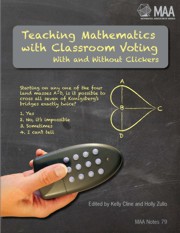Book contents
- Frontmatter
- Contents
- I An Introduction to Teaching Mathematics with Classroom Voting
- II Studies of Classroom Voting in Mathematics
- III Classroom Voting in Specific Mathematics Classes
- 6 Questions to Engage Students in Discussion (Q.E.D): Using Clickers in a Mathematics for Liberal Arts Course
- 7 Clickers in Introductory Statistics Courses
- 8 Using Clickers in a Statistics Classroom
- 9 Engaging Statistics Students with Classroom Response Systems
- 10 Incorporating Clicker Technology in the Introductory Statistics Course
- 11 Using Clickers in Courses for Future K–8 Teachers
- 12 Using Clickers in Professional DevelopmentWorkshops
- 13 Using ConcepTests in College Algebra
- 14 An Example of Multi-Purpose Use of Clickers in College Algebra
- 15 ConcepTests—Classroom Voting: A Catalyst for an Interactive College Algebra ClassroomD
- 16 Using Clickers to Encourage Communication and Self-Reflection in Precalculus
- 17 Writing and Adapting Classroom Voting Questions: New Functions from Old
- 18 Enhancing Student Participation and Attitudes in a Large-Lecture Calculus Course
- 19 Good Questions for Mathematics Eduction: An Example from Multivariable Calculus
- 20 Integrating Classroom Voting Into Your Lectures: Some Thoughts and Examples from a Differential Equations Course
- 21 Classroom Voting Questions that Provoke Teachable Moments in Differential Equations
- 22 Teaching Linear Algebra with Classroom Voting: A Class Period on Linear Independence
- 23 Lesson Planning with Classroom Voting: An Example from Linear Algebra
- 24 Using Clickers to Enhance Learning in Upper-Level Mathematics Courses
- Bibliography
- About the Editors
21 - Classroom Voting Questions that Provoke Teachable Moments in Differential Equations
from III - Classroom Voting in Specific Mathematics Classes
- Frontmatter
- Contents
- I An Introduction to Teaching Mathematics with Classroom Voting
- II Studies of Classroom Voting in Mathematics
- III Classroom Voting in Specific Mathematics Classes
- 6 Questions to Engage Students in Discussion (Q.E.D): Using Clickers in a Mathematics for Liberal Arts Course
- 7 Clickers in Introductory Statistics Courses
- 8 Using Clickers in a Statistics Classroom
- 9 Engaging Statistics Students with Classroom Response Systems
- 10 Incorporating Clicker Technology in the Introductory Statistics Course
- 11 Using Clickers in Courses for Future K–8 Teachers
- 12 Using Clickers in Professional DevelopmentWorkshops
- 13 Using ConcepTests in College Algebra
- 14 An Example of Multi-Purpose Use of Clickers in College Algebra
- 15 ConcepTests—Classroom Voting: A Catalyst for an Interactive College Algebra ClassroomD
- 16 Using Clickers to Encourage Communication and Self-Reflection in Precalculus
- 17 Writing and Adapting Classroom Voting Questions: New Functions from Old
- 18 Enhancing Student Participation and Attitudes in a Large-Lecture Calculus Course
- 19 Good Questions for Mathematics Eduction: An Example from Multivariable Calculus
- 20 Integrating Classroom Voting Into Your Lectures: Some Thoughts and Examples from a Differential Equations Course
- 21 Classroom Voting Questions that Provoke Teachable Moments in Differential Equations
- 22 Teaching Linear Algebra with Classroom Voting: A Class Period on Linear Independence
- 23 Lesson Planning with Classroom Voting: An Example from Linear Algebra
- 24 Using Clickers to Enhance Learning in Upper-Level Mathematics Courses
- Bibliography
- About the Editors
Summary
Classroom voting has become recognized as a powerful teaching technique in many courses including the calculus sequence (see e.g., [16, 59]). To build on this success, we have developed a library of over 300 classroom voting questions for differential equations with the primary goal of creating useful student discussions that will help teach this material (questions available at http://mathquest.carroll.edu).
After writing this collection, the next step was to test the questions by using them in our courses and collecting data on the voting results. The authors teach at a variety of different institutions, allowing us to see how well this teaching method worked with different groups of students. Cline, Zullo, and Parker teach at Carroll College in Montana, a small private liberal arts college with a traditional residential student body, and Harris teaches at a similar institution in Kentucky. Stewart teaches at Hood College in Maryland, a small private liberal arts college with a mix of residential and commuter students. Storm teaches at Adelphi, a university in New York with a strong regional draw that is primarily a commuting campus. George teaches at a public high school in Montana.
We found that classroom voting can be a very powerful way of revealing student misconceptions, so that they can be directly addressed. Rather than trying to anticipate the common difficulties that students have and designing a lesson to prevent students from making these errors, instead we found it more useful to ask questions which provoked the errors, helping students to confront these issues directly.
- Type
- Chapter
- Information
- Teaching Mathematics with Classroom VotingWith and Without Clickers, pp. 141 - 148Publisher: Mathematical Association of AmericaPrint publication year: 2011



